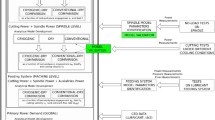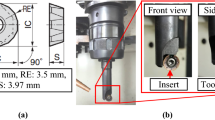Abstract
Improve machining processes from an environmental point of view is a hot topic currently. In this line, cryogenics CO2 is presented as a solution to substitute conventional oil emulsions. However, to be applied industrially, it is needed to control CO2 flow rate with the aim of reducing CO2 consumption to reach what it is known as ECO2-performance (economy + ecology). Then, despite currently CO2 cooling technique is used as external coolant, it is needed to improve its use—especially in milling processes—for achieving this goal. In line with this, in this paper is presented the use of CO2 as tool internal coolant as a solution to optimize its use. For checking its suitability, a study based on computer fluid dynamics with a new cryogenic tool channels design and experimental tests were carried out for analyzing the differences between using CO2 as internal and external coolant with the aim of improving the use of cryogenic gases during Inconel 718 milling processes. The results show that the use of CO2 as internal coolant improves the current milling process not only from environmental point of view but also economic and technical, bringing CO2 cryogenic technology closer to industrial milling conditions.









Similar content being viewed by others
References
Madanchi, N., Zellmer, S., Winter, M., Flach, F., Garnwitner, G., & Herrmann, C. (2019). Investigation on the effects of nanoparticles on cutting fluid properties and tribological characteristics. International Journal of Precision Engineering and Manufacturing-Green Technology, 6(3), 443–447.
An, Q., & Dang, J. (2019). Cooling effects of cold mist jet with transient heat transfer on high-speed cutting of titanium alloy. International Journal of Precision Engineering and Manufacturing-Green Technology. https://doi.org/10.1007/s40684-019-00076-7.
Pereira, O., Rodríguez, A., Fernádez-Abia, A. I., Barreiro, J., & López de Lacalle, L. N. (2016). Cryogenic and minimum quantity lubrication for an eco-efficiency turning of AISI 304. Journal of Cleaner Production, 139, 440–449.
Pereira, O., Urbikaín, G., Rodríguez, A., Fernández-Valdivielso, A., Calleja, A., Ayesta, I., & López de Lacalle, L. N. (2017). Internal cryolubrication approach for Inconel 718 milling. Procedia Manufacturing, 13, 89–93.
Miller, S. (1996). Advanced materials means advanced engines. Interdisciplinary Science Reviews, 21, 117–129.
Pereira, O., Martín-Alfonso, J. E., Rodríguez, A., Calleja, A., Fernández-Valdivielso, A., & López de Lacalle, L. N. (2017). Sustainability analysis of lubricant oils for minimum quantity lubrication based on their tribo-rheological performance. Journal of Cleaner Production, 164, 1419–1429.
Tebaldo, V., Gautierdi Confiengo, G., & Giulia, M. (2017). “Eco-friendly” turning of Inconel 718. Surface characterisation and economic analysis. Journal of Cleaner Production, 130, 1567–1577.
Stephenson, D., Skerlos, S., King, A., & Supekar, S. (2014). Rough turning Inconel 750 with supercritical CO2-based minimum quantity lubrication. Journal of Materials Processing Technology, 214, 673–680.
Klocke, F., Krämer, A., Sangermann, H., & Lung, D. (2012). Thermo-mechanical tool load during high performance cutting of hard-to-cut materials. Procedia CIRP, 1, 295–300.
Krammer, A., Klocke, F., Sangermann, H., & Lung, D. (2013). Influence of the lubricoolant strategy on thermo-mechanical tool load. CIRP Journal of Manufacturing Science and Technology, 7, 40–47.
Shokrani, A., Dhokia, V., & Newman, S. T. (2016). Investigation of the effects of cryogenic on surface integrity in CNC end milling of Ti6Al4V titanium alloy. Journal of Manufacturing Processes, 21, 172–179.
Ravi, S., & Kumar, M. P. (2011). Experimental investigations on cryogenic cooling by liquid nitrogen in the end milling of hardened steel. Cryogenics, 51, 509–515.
Hong, S. Y., & Ding, Y. (2001). Cooling approaches and cutting temperatures in cryogenic machining of Ti6Al4V. International Journal of Machine Tools and Manufacture, 41, 1417–1437.
Strano, M., Chiappini, E., Tirelli, S., Albertelli, P., & Monn, M. (2013). Comparison of Ti6Al4V machining forces and tool life for cryogenic versus conventional cooling. Journal of Engineering Manufacture, 227, 1403–1408.
Superkar, S., Clarens, A., Stephenson, D., & Skerlos, S. (2012). Performance of supercritical carbon dioxide sprays as coolants and lubricants in representative metalworking operations. Journal of Materials Processing Technology, 212, 2652–2658.
Pereira, O., Català, P., Rodríguez, A., Ostra, T., Vivancos, J., Rivero, A., & López de Lacalle, L. N. (2015). The use of hybrid CO2+MQL in machining operations. Procedia Engineering, 132, 492–499.
Pereira, O., Rodríguez, A., Barreiro, J., Fernández-Abia, A. I., & López de Lacalle, L. N. (2017). Nozzle design of combined use of MQL and cryogenic gas in machining. International Journal of Precision Engineering and Manufacturing-Green Technology, 4, 87–95.
Shih, T. H., Liou, W. W., Shabbir, A., Yang, Z., & Zhu, J. (1995). A new k-ε eddy viscosity model for high reynolds number turbulent flows. Computers and Fluids, 24, 227–238.
Pusavec, F., Deshpande, A., Yang, S., M’Saoubi, R., Kopac, J., Dillon, O. W., Jr., & Jawahir, I. (2014). Sustainable machining of high temperature nickel alloy—Inconel 718: part 1—predictive performance models. Journal of Cleaner Production, 81, 255–269.
López de Lacalle, L. N., Pérez-Bilbatua, J., Sánchez, J., Llorente, J. I., & Gutiérrez, A. J. (2000). Using high pressure coolant in the drilling and turning of low machinability alloys. Journal of Advanced Manufacturing Technology, 16, 85–91.
Fernández-Valdivielso, A., Lópezde Lacalle, L. N., Urbikain, G., & Rodríguez, A. (2016). Detecting the key geometrical features and grades of carbide inserts for the turning of nickel-based alloys concerning surface integrity. Proceedings of the Institution of Mechanical Engineers, Part C Journal of Mechanical Engineering Science, 230, 3725–3742.
Alauddin, M., El Baradie, M. A., & Hashmi, M. S. J. (1995). Tool-life testing in the end of Inconel 718. Journal of Materials Processing Technology, 55, 321–330.
Acknowledgements
The authors wish to acknowledge the financial support received from the Spanish Ministry of Economy and Competitiveness with the project TURBO (DPI2013-46164-C2-1-R), Grant number [BES-2014-068874], to HAZITEK program from the Department of Economic Development and Infrastructures of the Basque Government and from FEDER founds, related to the project with acronym HARDCRAFT and Vice chancellor of innovation, social compromise and cultural action from UPV/EHU (Bizialab program from Basque Government). Finally, thanks are also addressed to funds from Excellence groups of the Basque university system IT1337-19, to Spanish Project MINECO DPI2016-74845-R and RETOS RTC-2014-1861-4 and RTC-2017-6039 (NewMine).
Author information
Authors and Affiliations
Corresponding author
Additional information
Publisher's Note
Springer Nature remains neutral with regard to jurisdictional claims in published maps and institutional affiliations.
Rights and permissions
About this article
Cite this article
Pereira, O., Rodríguez, A., Calleja-Ochoa, A. et al. Simulation of Cryo-cooling to Improve Super Alloys Cutting Tools. Int. J. of Precis. Eng. and Manuf.-Green Tech. 9, 73–82 (2022). https://doi.org/10.1007/s40684-021-00313-y
Received:
Revised:
Accepted:
Published:
Issue Date:
DOI: https://doi.org/10.1007/s40684-021-00313-y




